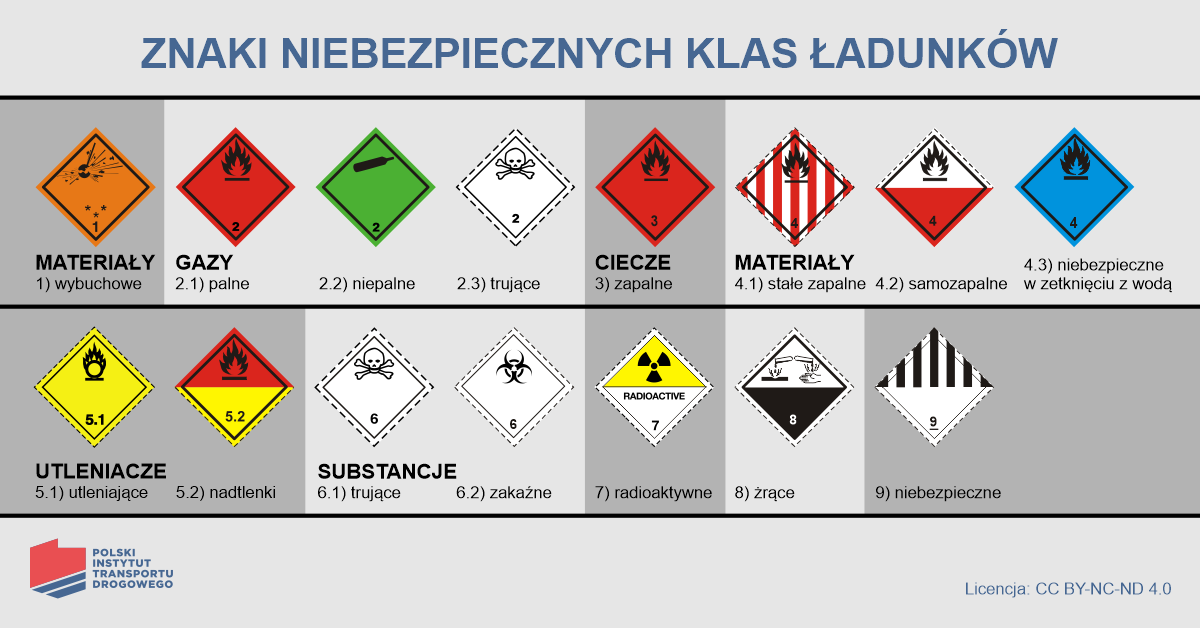
DANGEROUS goods IN 2023
On February 16, 2023, we participated in the debate "Dangerous cargo - new rules in 2023." The following took part in the debate:
- Frederic Kowalski - Adecon
- Bartłomei Sporysz - Rohlig Suus
- Anna Pytel - Adecon
- Barłomiej Kowalczyowski - DGM Poland
The debate was organized by the Polish Road Transport Institute. The debate was led by Anna Majowicz - Operations Director.

Debt speakers

Markings of classes of dangerous goods, in accordance with the ADR agreement
Lithium-ion batteries must not be stored in the vicinity of flammable items. In addition, the transport of such cells should have the required test report. In the case of warehouses, the type of stored substances should be determined already at the stage of planning the type and size of facilities in order to adapt the necessary infrastructure to them. When is a warehouse classified as a plant with an increased risk of an industrial accident? What is cross-docking? Detailed guidelines and changes in the regulations on dangerous cargo were presented by experts during the ninth edition of the Workshop for Transport and Logistics Managers - "Dangerous cargo - new rules in 2023".
Contents
Cross-docking an opportunity for faster delivery of dangerous cargo
"In the case of cross-docking of dangerous goods, we only have 48 hours to hold such goods without the safeguards normally required. It is also important to remember that if a dangerous good is damaged, it must not be released on the road. It must then be accepted and properly secured, only then can it continue on its way" warns Frederic Kowalski, Manager Battery Warehouse at Adecon.
"The problem is often a warehouse operating on a cross-docking basis. Packing a container is subject to the IMDG Code, there are segregation tables and 18 segregation groups. These must be observed and the goods must be loaded appropriately in the warehouse. The marking of the container is also the responsibility of the shipper. The packer, shipper and sender all have specific responsibilities" adds Bartek Kowalczykowski, CBTA project specialist at DGM Polska.
Air transport with stringent requirements
"There are many restrictions on the transport of dangerous goods by air. Many more than for road transport, for example. Often, goods that are excluded from this category on the road are classified as hazardous in air transport. This is because it is not possible to act in the air in the event of a packaging defect or leak. Only after landing can some kind of neutralisation be undertaken. In general, all the required markings for air transport are accepted in road transport, but the opposite is not the case." points out Anna Pytel, air freight forwarder at Adecon.
According to the new law of 17.08.2022, all air freight forwarders must be trained.
"The Civil Aviation Authority has shifted the responsibility to freight forwarders (Dangerous Goods Declaration DGD). The CAA can issue special permits for the carriage of dangerous goods and has the ability to penalise shippers for unregistered dangerous goods. The shipper in this light is the individual and he will pay the penalty imposed by the authority" Anna Pytel adds.
Dangerous goods - what does it mean ?
"Category 9 includes miscellaneous materials, defined as multiple hazards or hazards not defined in time. These include goods such as dry ice, fishmeal, polymer balls, but importantly also lithium-ion batteries" points out Bartek Kowalczykowski.
Hazardous goods in a secure warehouse
High-risk industrial accident facility
Lithium-ion batteries can be a hazard
Strategic goods with WSK (Internal control system) requirement
1) materials, chemicals, "micro-organisms" and "toxins";
2) material processing;
3) electronics;
4) computers;
5) telecommunications and "information security";
6) sensors and lasers;
7) navigation and avionics;
8) ship equipment;
9) cosmonautics, aeronautics, propulsion.
Changes to ADR rules
"The most important changes concern lithium-ion batteries. Facilitations have been introduced for the transport of toxic goods. Currently, their quantity estimation may be based on the quantity carrier. Another change concerns machinery and equipment containing dangerous goods, if the content exceeds the LQ level, they must be assigned a UN number. As a result of the amendment, the transitional period regarding dangerous goods representatives has expired. It should also be mentioned that hybrid vehicles are now allowed to transport tanks. This is in line with the increasing importance of hybrids and electric vehicles in ADR road transport. With the increasing lack of explosiveness, electric tractors will gradually carry tanks other than AT", says Bartłomiej Sporysz.

 .
.